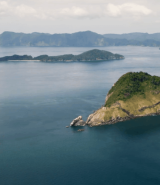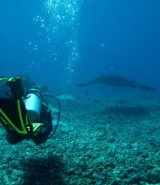 A year or two back I used to live in Asia. Thailand specifically. I love the Thai people as a rule of thumb. It’s quite easy to generalise and slip into national stereotypes, but I found that almost without exception the Thai people to be welcoming and humble people. The guys and girls I worked with on the liveaboard boat couldn’t do enough to help you and would often go above and beyond the call of duty to make sure you felt at home and that things ran smoothly. If you’ve not been to Thailand, shame on you. As soon as you’ve finished reading this book your flights.
A year or two back I used to live in Asia. Thailand specifically. I love the Thai people as a rule of thumb. It’s quite easy to generalise and slip into national stereotypes, but I found that almost without exception the Thai people to be welcoming and humble people. The guys and girls I worked with on the liveaboard boat couldn’t do enough to help you and would often go above and beyond the call of duty to make sure you felt at home and that things ran smoothly. If you’ve not been to Thailand, shame on you. As soon as you’ve finished reading this book your flights.
But, If you’ve spent any time there you will have probably picked up the phrase ‘same same, but different’. It’s a phrase that the Thai people seem to have latched onto. It seems like an oxymoron, but a rough translation is ‘the object we’re talking about has one or more characteristics of the other object we were talking about previously, but has a few key differences’. Example: the t-shirt you’ve picked up is the same size and design as the other one, but is a different colour. It’s a bit ‘same same, but different’. It’s a bit like that with the PADI Advanced Open Water course compared to the PADI Open Water Course.
Firstly, lets talk about the name of the course: Advanced Open Water. There’s been grumbling and mumbling about the name of the course for as long as I’ve been around diving. Conceivably, if you’ve gone straight from your Open Water course to your Advanced course you could be completed with a minimum of 9 dives in your log book. Are you an ‘Advanced’ diver with 9 dives under your belt? No. Think of the Advanced Open Water certification as more of an ‘Open Water (Advanced)‘ or ‘Open Water Plus‘ as opposed to ‘Advanced‘ in it’s own right. But, it’s a useful next step to take and you’ll learn some essential skills that will certainly stand you in good stead.
As I said last week, this is the next step – not an Open Water refresher course – so do make sure you haven’t discarded all the basics before your turn up. Hopefully you can still remember how to assemble your equipment, buddy check and plan your dives. If you’re not sure, get in contact with your local dive centre and do a scuba tune up beforehand.
The Advanced Open Water has two ‘core’ components; the ‘deep’ adventure dive and the ‘navigation’. The qualification then allows to dive to a depth of 30m. These dives and, more importantly, the knowledge and experience you gather on these two dives are key for starting to dive at greater depth or independently with your buddy.
First, lets look at the deep dive. The thing with going slightly deeper is it’s not just about whether you feel comfortable there. This is a common misunderstanding. That’s just part of the picture. It’s the other aspects of a deeper dive that you need to consider. Those aspects were still there when you were in diving at 12m, just less apparent. This is (sometimes) where a cocky Open Water diver can put themselves in danger “oh, it’s only another 12m and I was fine at 18m, doing training is a waste of time…”. This puts them, potentially, in physical danger and (as we discussed in the earlier article on Risk Management) means they may be operating outside the bound of their insurance coverage – i.e they’re up sh*t creek if it all goes wrong.
The first thing major change is your no-decompression limit (NDL). At 12m bimbling around a reef your NDL isn’t a big factor. If you dig out your RDP you’ll find at 12m you have 147 minutes to play with. On a standard 12 litre cylinder, unless you have the lungs of a church mouse and the thermal properties of a walrus, you’re not going to get close to a 2hr 27 minute dive. You’ll run out of gas before then. Or get cold. Or both. BUT, suddenly at 30m you only have 20mins to play with. Even at a more reasonable depth of 22m you have only 37 minutes on air. And that’s given that it’s your first dive of the day and there’s no residual nitrogen floating around your system. Therefore, you need to plan your dive effectively. You’ve got that window of time to get down there and do what you’d like to do; whether that’s seeing a certain aspect of a wreck, or finding the tigertail seahorse you’ve been told about. So it’s no good to randomly drop down and swim around hoping for the best (which is where the navigation comes in later…). Be relaxed, of course, but know you need to have one eye on your dive time. Remember doing your S.O.R.T.D. on your open water course 5 point descent? that’s why. ‘T’ is for time. That’s when you start your timer or set the bezel on your watch. Ok smarty-pants, I know these days most people carry a computer – which is a good idea – but it’s worth having a watch too in case your computer throws a wobbly.
Next thing to consider is air consumption. Back to chapter 1 of your open water manual. Guess what? at 30m you’re under 4 ata of pressure. You’re going to drink your air 4 times as quick all things being equal. Maybe more if you’re excited or nervous and your pulse creeps up. So, don’t go into the dive blindly. Take a look at your log book. How much gas have you been consuming at 18m? What length were those dives and what was the profile? i.e did you only spend 5 minutes at 18m and the rest at 8m looking at a clown fish? Most divers of experience work on a rule of thirds. A third out, third back, third reserve. If you think of an average tank fill as being around 200-210 bar that places you back on your 5m/3mins safety stop with a margin for error. Agree your ‘turn point’ with your buddy before the dive e.g 120bar. You may want to use a 15l tank and/or carry a pony bottle depending on where you are in the world and what you’re doing. And certainly an SMB in case you have to surface away from the agreed ascent point due to gas consumption.
Then, there’s the other rinky-dinks people often forget on deeper dives. Temperature. If you’re in Bali then chances are you don’t have to worry – it’s 29c all the way down. Lucky sod. If you’re in a lake in the UK or Canada that’s a whole different kettle of fish. The water temperature could drop 10c. Take your gloves and hoodie ‘cos it’s going to be like walking into the freezer section of Tesco’s down there.
Light. There’s going to be less. A torch is always handy – even during the day. It’s great for looking under rocks, crevices or shining inside a wreck. Or simply to bring some of the colour back to wildlife you’ve found.
Stops. Think about how and where you’re going to do your safety stops. Do you need to make your way back to a shot line on a wreck? are you coming back to shore? or hovering in the blue with a reel and smb? Are your group comfortable with that? What about baot traffic? how are you going to signal when your three minutes is up? It’s a little thing but you’ll be amazed how many people miss this out and float around looking at each other with a confused expression pointing at their computers. Agree some signals. You’re diving as a team.
The second ‘core’ to the Advanced Open Water course is navigation. Now, I know you all learned how to use a compass on your Open Water course so I won’t waste time on explaining what a lubber line is etc. What I will do is tell you where navigation cock-ups often occur:
- Going too quick: Slow down and don’t go swimming off like a polaris missile. Take your time. Gentle fin strokes. Check in regularly with your buddy as you would (should) normally.
- Obsessing on the compass: You’re multi-tasking here. Don’t ignore everything else and focus 100% on the compass and swim head first into the jetty or quay. Look around too! Use some natural navigation to help you too.
- Forgetting the buoyancy basics: Keep an eye on your depth gauge too! We’re back to multi-tasking again. Don’t forget your buoyancy. Often new ‘navigators’ end up snorkelling with their reg or trying to disappear down an abyss as they’re staring at their compass at the expense of thinking buoyancy.
- Using (or not using!) your buddy: Giving a new diver a compass is a bit like giving them a camera. They love it and ‘whoosh’ they’re off in their own little world, running into problems points 1, 2 and 3. Use the buddy system to your advantage. If you’re compass handler, why not let your buddy help you with pacing and depth. It’s a team game.
And, don’t worry if it all goes wrong on your first attempt at a square navigation pattern underwater. We all do it. Try again. Practice. Even if you’ve done 1000’s of dives it can still go Pete Tong from time to time.
Now, that’s not an all-inclusive list of how to dive deeper and navigate better, but it’s a start. The rest will come from training and experience. Like I said, the Advanced Open Water builds on the basic buoyancy, navigation and dive planning you learned on your Open Water. It’s same-same but different.
Safe diving.
The Scuba Monkey
 Destinations
Destinations









Your Comments
No comment yet on this page, your thoughts are welcome!
Have you been travelling or scuba diving here? Rate it!(3 votes, 4.67/5)